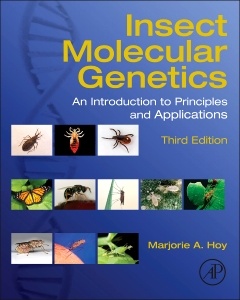Insect Molecular Genetics (3rd Ed.) An Introduction to Principles and Applications
Auteur : Hoy Marjorie A.

Insect Molecular Genetics, Third Edition, summarizes and synthesizes two rather disparate disciplines?entomology and molecular genetics. This volume provides an introduction to the techniques and literature of molecular genetics; defines terminology; and reviews concepts, principles, and applications of these powerful tools. The world of insect molecular genetics, once dominated by Drosophila, has become much more diverse, especially with the sequencing of multiple arthropod genomes (from spider mites to mosquitoes). This introduction includes discussion of honey bees, mosquitoes, flour beetles, silk moths, fruit flies, aphids, house flies, kissing bugs, cicadas, butterflies, tsetse flies and armyworms.
This book serves as both a foundational text and a review of a rapidly growing literature. With fully revised and updated chapters, the third edition will be a valuable addition to the personal libraries of entomologists, geneticists, and molecular biologists.
PART I: GENES AND GENOME ORGANIZATION IN EUKARYOTES
1. DNA, Gene Structure, and DNA Replication
2. Transcription, Translation, and Regulation of Eukaryotic DNA
3. Nuclear and Extranuclear DNA in Insects
4. Genetic Systems, Genome Evolution, and Genetic Control of Embryonic Development in Insects
PART II: MOLECULAR GENETIC TECHNIQUES
5. Some Basic Tools: How to Cut, Paste, Copy, Measure, Visualize, and Clone DNA
6. Some Additional Tools For the Molecular Biologist
7. DNA Sequencing and the Evolution of the "-Omics"
8. DNA Amplification by the Polymerase Chain Reaction: Molecular Biology Made Accessible
9. Transposable-Element Vectors and Other Methods To Genetically Modify Drosophila and Other Insects
PART III: APPLICATIONS IN ENTOMOLOGY
10. Sex Determination in Insects
11. Molecular Genetics of Insect Behavior
12. Molecular Systematics and Evolution of Arthropods
13. Insect Population Ecology and Molecular Genetics
14. Genetic Modification of Pest and Beneficial Insects for Pest Management Programs
Glossary
Index
Hoy was born in Kansas City, KS in 1941. She attended the University of Kansas for her B.A. as a National Merit scholar and Elizabeth M. Watkins scholar, graduating Phi Beta Kappa in 1963. She obtained the M.S. (1966) and Ph.D. (1972) from the University of California–Berkeley (UCB). After completing the Ph.D., she worked at the Connecticut Agricultural Station and the U.S. Forest Service on genetic improvement of natural enemies of the gypsy moth. In 1976, she returned to UCB as an assistant professor and is an emeritus full professor. Her project on genetic improvement of M. occidentalis demonstrated, for the first time, that a laboratory-selected natural enemy could be deployed effectively in an IPM program in CA almond orchards. In 1992, she accepted an endowed chair (Davies, Fischer and Eckes professor of biological control) at UF, where she teaches courses in agricultural acarology, insect molecular genetics, and bioterrorism.
Hoy’s laboratory conducts basic and applied research on natural enemies and recently sequenced the transcriptome and genome of the predatory mite M. occidentalis. She pioneered the use of genetics to develop improved natural enemies of pest insects and mites. Hoy has published more than 350 scientific papers and has completed the third edition of her textbook Insect Molecular Genetics. In 2011, she published Agricultural Acarology: Introduction to Integrated Mite Management. Books edited i
- Up-to-date references to important review articles, websites, and seminal citations in the disciplines
- Well crafted and instructive illustrations integral to explaining the techniques of molecular genetics
- Glossary of terms to help beginners learn the vocabulary of molecular biology
Date de parution : 10-2018
Ouvrage de 838 p.
19x23.3 cm
Ancienne édition
Accéder à la nouvelle édition.
Date de parution : 06-2013
Ouvrage de 838 p.
19x23.3 cm
Ancienne édition
Accéder à la nouvelle édition.



